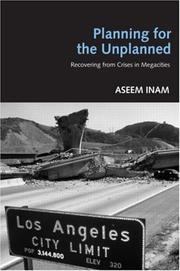
Planning for the unplanned
By Aseem Inam
Subjects: Rampen, Routines, Architecture, Infrastructure, Crises, Attentats du 11 septembre 2001, États-Unis, Urban & land use planning, BUSINESS & ECONOMICS, September 11 Terrorist Attacks, 2001, Planning institutions, Catastrophes, General, Emergency management, Sécurité urbaine, Safety measures, Gestion des situations d'urgence, Disaster relief, Cities and towns, Stadsplanning, SOCIAL SCIENCE, Disasters, City planning, Organisatie, September 11 terrorist attacks, 2001, Planning, Urban planning, Secours aux victimes de catastrophes, Planification
Description: How do cities plan for the unplanned? Do cities plan for recovery from every possible sudden shock? How does one prepare a plan for the recovery after a tragedy, like the September 11, 2001 terrorist attacks on New York? The book discovers the systematic features that contribute to the success of planning institutions. In cities filled with uncertainty and complexity, planning institutions effectively tackle unexpected and sudden change by relying on the old and the familiar, rather than the new and the innovative. The author argues that planning programs institutions were successful because they were bureaucratic, and relied on standardized routines, rigorous sets of established regimes, familiar programs, and institutionalized hierarchies. Also contrary to popular perception, neither the leaders at the top of the institutions nor those workers at the grassroots level were the most important in the implementation of such routines. The key actors were middle managers, because they knew the institutional structures inside out, what the routines were and how to use them, and were successful go-betweens between national governments and grassroots community groups. Case studies from Mexico City, Los Angeles and New York provide a deeper understanding of urban planning processes. The case studies reveal that systematic institutional analysis helps us understand what works in planning, and why. They also demonstrate the manner in which institutional routines serve as powerful and effective tools for addressing novel situations in cities.
Comments
You must log in to leave comments.